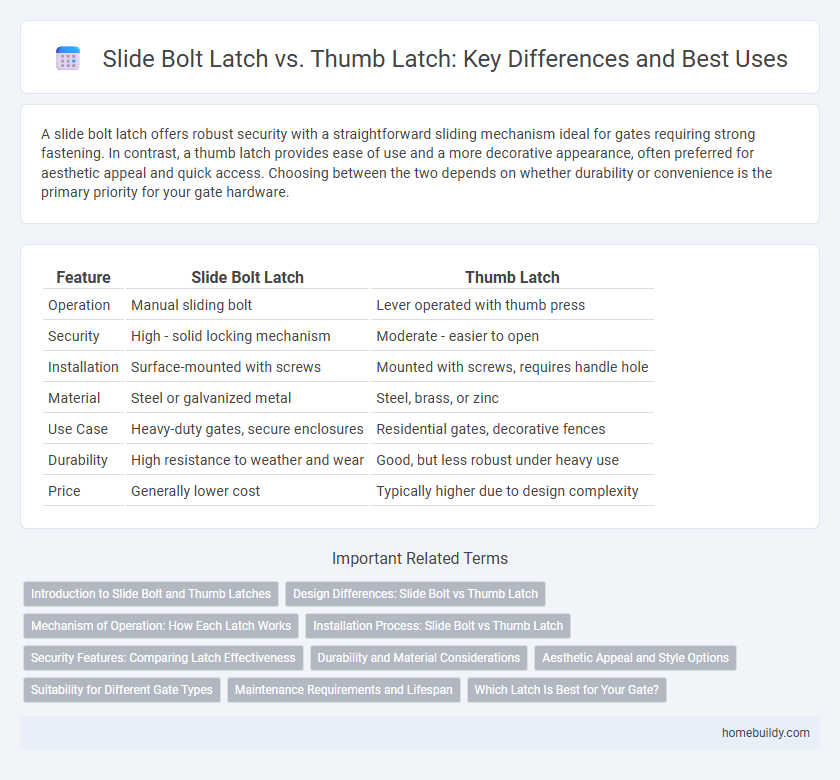A slide bolt latch offers robust security with a straightforward sliding mechanism ideal for gates requiring strong fastening. In contrast, a thumb latch provides ease of use and a more decorative appearance, often preferred for aesthetic appeal and quick access. Choosing between the two depends on whether durability or convenience is the primary priority for your gate hardware.
Table of Comparison
| Feature | Slide Bolt Latch | Thumb Latch |
|---|---|---|
| Operation | Manual sliding bolt | Lever operated with thumb press |
| Security | High - solid locking mechanism | Moderate - easier to open |
| Installation | Surface-mounted with screws | Mounted with screws, requires handle hole |
| Material | Steel or galvanized metal | Steel, brass, or zinc |
| Use Case | Heavy-duty gates, secure enclosures | Residential gates, decorative fences |
| Durability | High resistance to weather and wear | Good, but less robust under heavy use |
| Price | Generally lower cost | Typically higher due to design complexity |
Introduction to Slide Bolt and Thumb Latches
Slide bolt latches feature a straightforward mechanism where a metal bolt slides into a catch or bracket, offering reliable security for gates and doors. Thumb latches combine a handle and latch that operate together, providing easy one-handed access and traditional aesthetic appeal. Both types serve distinct functions, with slide bolts emphasizing strength and thumb latches focusing on convenience and style.
Design Differences: Slide Bolt vs Thumb Latch
Slide bolt latches feature a straight metal bolt that slides into a catch or bracket, providing a simple and sturdy locking mechanism ideal for heavy gates. Thumb latches incorporate a thumb-operated lever connected to a latch bar, offering ergonomic convenience and a traditional aesthetic often favored for decorative or wooden gates. The slide bolt design emphasizes strength and security, while the thumb latch prioritizes ease of use and visual appeal.
Mechanism of Operation: How Each Latch Works
A slide bolt latch operates by manually sliding a metal bolt into a catch or slot to secure a gate, providing a straightforward horizontal locking mechanism. In contrast, a thumb latch combines a handle and a latch bar that lifts when the thumb press is pressed, releasing the catch and allowing the gate to open. The slide bolt's simple linear motion contrasts with the thumb latch's lever action, influencing ease of use and mechanical complexity.
Installation Process: Slide Bolt vs Thumb Latch
The installation process for a slide bolt latch typically involves mounting two separate components: the bolt housing and the catch plate, which requires precise alignment to ensure smooth operation. In contrast, a thumb latch installation often necessitates fitting the handle, latch mechanism, and striker plate, demanding more intricate adjustment for secure and ergonomic functionality. Proper measurements and tools are crucial for both types to achieve durability and ease of use on gates or doors.
Security Features: Comparing Latch Effectiveness
Slide bolt latches provide robust security by offering a solid metal bolt that securely fastens gates, minimizing the risk of forced entry. Thumb latches, while easier to operate, typically feature less sturdy locking mechanisms, making them more vulnerable to tampering. In terms of security effectiveness, slide bolt latches are generally preferred for high-security gate applications due to their durability and resistance to prying.
Durability and Material Considerations
Slide bolt latches are typically constructed from heavy-duty steel or stainless steel, offering superior durability and corrosion resistance ideal for outdoor gate applications. Thumb latches often feature wrought iron or cast metal, providing a classic aesthetic but may require regular maintenance to prevent rust and wear. For long-lasting performance in harsh weather conditions, slide bolt latches generally offer a more robust and low-maintenance solution compared to thumb latches.
Aesthetic Appeal and Style Options
Slide bolt latches offer a minimalist and industrial aesthetic, often favored for modern or utilitarian gate designs due to their sleek, straightforward mechanism. Thumb latches provide a more traditional and decorative appeal, available in various styles such as ornate ironwork or rustic finishes, making them ideal for enhancing the charm of classic or vintage gates. Selecting between the two depends on the desired visual impact and the architectural style of the surrounding environment.
Suitability for Different Gate Types
Slide bolt latches are highly suitable for heavy-duty wooden and metal gates due to their robust design and ease of installation on flat surfaces. Thumb latches are ideal for ornamental or garden gates where aesthetic appeal and ease of one-handed operation are prioritized. Each latch type offers specific advantages: slide bolt latches provide strong security for larger gates, while thumb latches enhance functionality and visual charm for lighter, decorative gates.
Maintenance Requirements and Lifespan
Slide bolt latches typically require minimal maintenance, involving occasional lubrication and tightening of screws to ensure smooth operation, contributing to a longer lifespan of up to 10-15 years. Thumb latches, with more moving parts and exposed mechanisms, may need regular cleaning and lubrication to prevent rust and wear, potentially shortening their lifespan to around 7-10 years. Both latch types benefit from weather-resistant materials, but slide bolt latches generally offer greater durability and lower maintenance needs over time.
Which Latch Is Best for Your Gate?
Slide bolt latches offer robust security and easy operation for heavy-duty gates, making them ideal for high-traffic areas or larger gates requiring strong holding power. Thumb latches provide a more traditional, decorative appeal with simpler mechanics, suitable for garden or ornamental gates where aesthetics and ease of use are key. Choosing the best gate latch depends on balancing security needs, gate size, and design preferences to ensure optimal functionality and appearance.
slide bolt latch vs thumb latch Infographic

 homebuildy.com
homebuildy.com